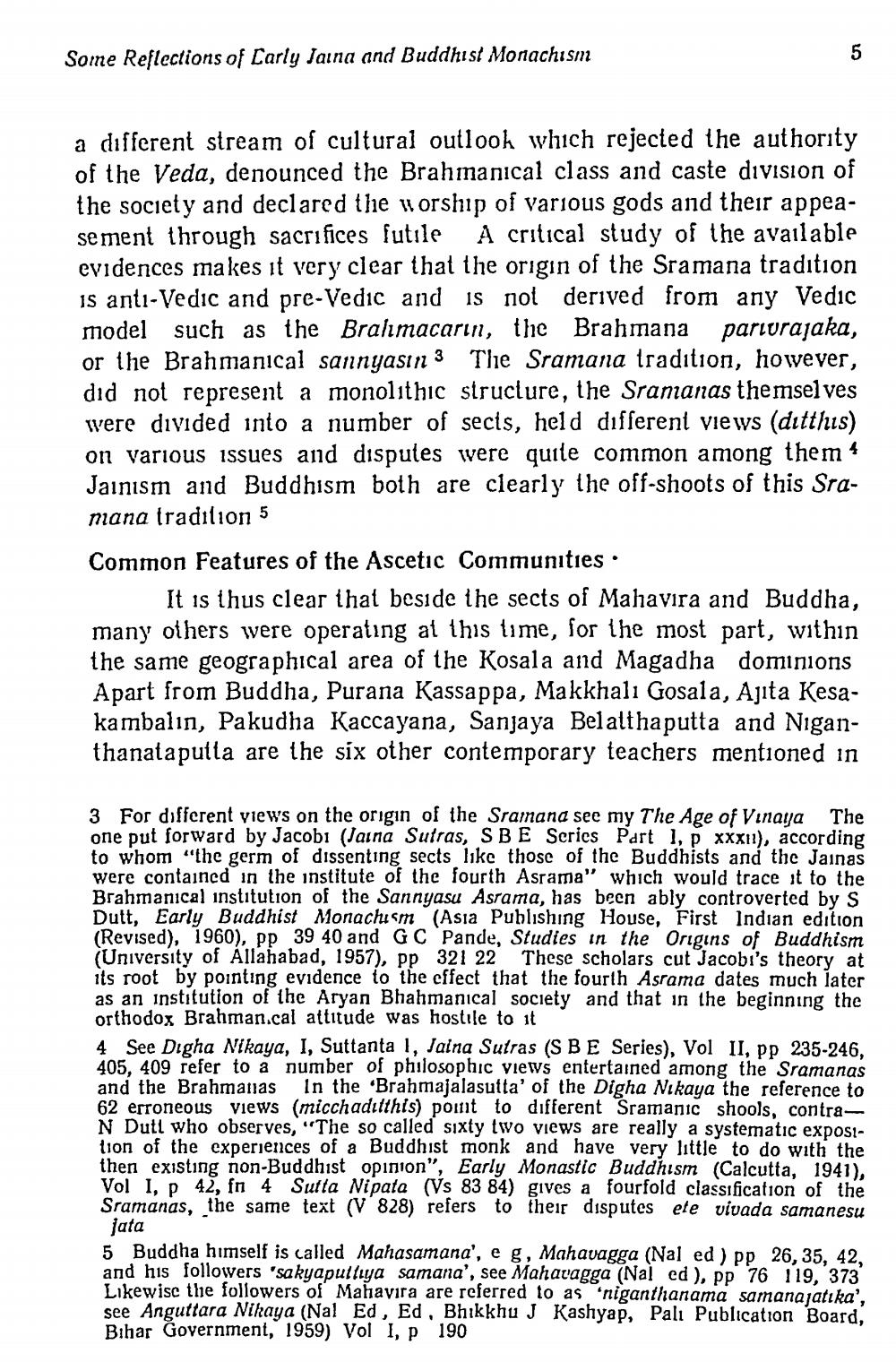________________
Some Reflections of Carly Jaina and Buddhist Monachism
a different stream of cultural outlook which rejected the authority of the Veda, denounced the Brahmanical class and caste division of the society and declared the worship of various gods and their appeasement through sacrifices futile A critical study of the available evidences makes it very clear that the origin of the Sramana tradition is anti-Vedic and pre-Vedic and is not derived from any Vedic model such as the Bralımacarin, the Brahmana pariurajaka, or the Brahmanical sannyasını 3 The Sramana tradition, however, did not represent a monolithic structure, the Srananas themselves were divided into a number of secis, held different views (ditthis) on various issues and disputes were quite common among them 4 Jainism and Buddhism both are clearly the off-shoots of this Sramana tradition 5 Common Features of the Ascetic Communities.
It is thus clear that beside the sects of Mahavira and Buddha, many others were operating at this time, for the most part, within the same geographical area of the Kosala and Magadha dominions Apart from Buddha, Purana Kassappa, Makkhali Gosala, Ajita Kesaka mbalin, Pakudha Kaccayana, Sanjaya Belalt haputta and Niganthanatapulta are the six other contemporary teachers mentioned in
3 For different views on the origin of the Sramana see my The Age of Vinaya The one put forward by Jacobi (Jaina Sutras, SBE Scrics Part 1, XXXu), according to whom "the germ of dissenting sects like those of the Buddhists and the Jainas were contained in the institute of the fourth Asrama" which would trace it to the Brahmanical institution of the Sannyasu Asrama, has been ably controverted by S Dutt, Early Buddhist Monachusm (Asia Publishing House, First Indian edition (Revised), 1960), pp 39 40 and GC Pande, Studies in the Origins of Buddhism University of Allahabad, 1957), pp 321 22 These scholars cut Jacobi's theory at its root by pointing evidence to the effect that the fourth Asrama dates much later as an institution of the Aryan Bhahmanical society and that in the beginning the orthodox Brahman.cal attitude was hostile to it 4. See Digha Nikaya, I, Suttanta 1, Jaina Sutras (S BE Series), Vol II, pp 235-246. 405. 409 refer to a number of philosophic views entertained among the Sramanas and the Brahmanias in the Brahmajalasutta' of the Digha Nikaya the reference to 62 erroneous views (micchaditthis) point to different Sramanic shools, contra N Dutt who observes, "The so called sixty two views are really a systematic exposition of the experiences of a Buddhist monk and have very little to do with the then existing non-Buddhist opinion", Early Monastic Buddhism (Calcutta, 1941), Vol I. p. 42, fn 4 Sutta Nipata (Vs 83 84) gives a fourfold classification of the Sramanas, the same text (V 828) refers to their disputes ete vivada samanesu
jata 5 Buddha himself is called Mahasamana', eg, Mahavagga (Nal ed) pp 26, 35, 42, and his followers 'sakyaputlıya samana', see Mahavagga (Nal ed), pp 76 119, 373 Likewisc the followers of Mahavira are referred to as 'niganthanama samanajati ka'. see Anguttara Nikaya (Nal Ed, Ed, Bhikkhu J Kashyap, Pali Publication Board, Bihar Government, 1959) Vol 1, p 190




